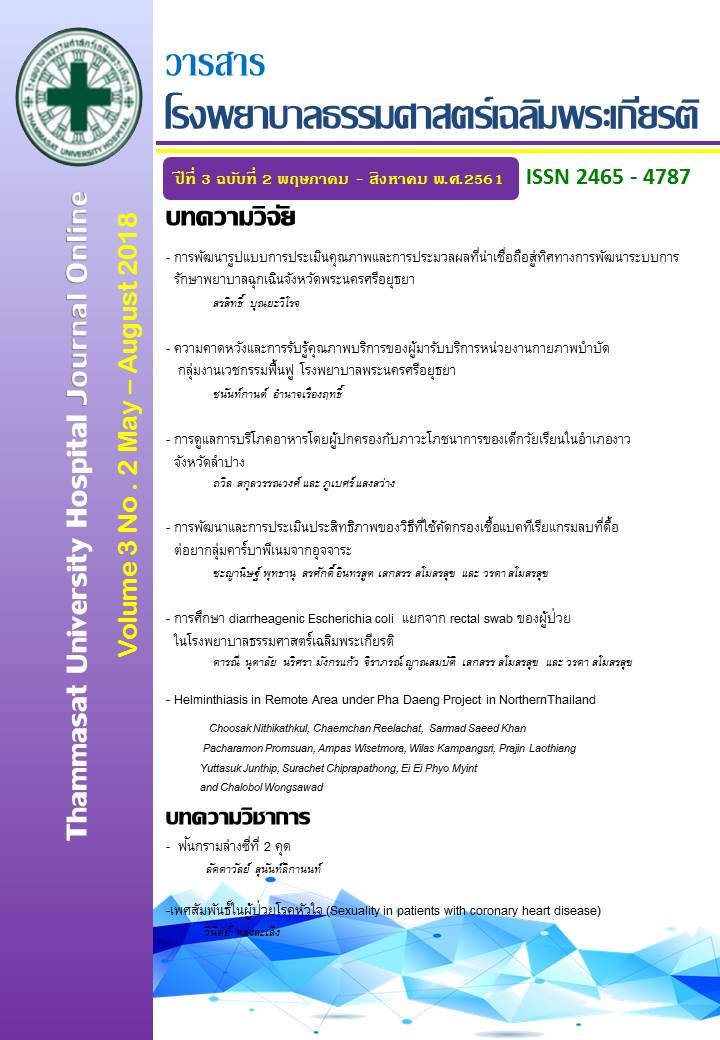การศึกษา diarrheagenic Escherichia coli แยกจาก rectal swab ของผู้ป่วยในโรงพยาบาลธรรมศาสตร์เฉลิมพระเกียรติ
คำสำคัญ:
diarrheagenic Escherichia coli (DEC), enteroaggregative E. coli (EAEC), enteropathogenic E. coli (EPEC),, enterotoxigenic E. coli (ETEC), enteroinvasive E. coli (EIEC), enterohaemorrhagic E. coli (EHEC))บทคัดย่อ
ความสำคัญของปัญหา : Diarrheagenic Escherichia coli (DEC) เป็นแบคทีเรียก่อให้เกิดโรคอุจจาระร่วงที่เป็นปัญหาสำคัญ ทั้งในประเทศที่พัฒนาแล้วและประเทศกำลังพัฒนา รวมถึงประเทศไทย อย่างไรก็ตาม ห้องปฏิบัติการจุลชีววิทยาของโรงพยาบาลทั่วไป ไม่ได้ตรวจหาเชื้อ DEC ในงานประจำวัน
วัตถุประสงค์ : การศึกษาในครั้งนี้เพื่อตรวจหาDEC จาก rectal swab ของผู้ป่วย ในโรงพยาบาลธรรมศาสตร์
วิธีดำเนินการวิจัย :โดยนำ rectal swab จำนวน 70 ตัวอย่าง มาเพิ่มจำนวนเชื้อใน tryptic soy broth เพื่อเตรียม boiled template และตรวจหา DEC ด้วยวิธี PCR โดยทดสอบต่อยีน a) aggR และ Eagg สำหรับตรวจหา enteroaggregative E. coli (EAEC), b) bfpA และ eaeA สำหรับตรวจหา enteropathogenic E. coli (EPEC), c) elt และ est สำหรับตรวจหา enterotoxigenic E. coli (ETEC), d) invE สำหรับตรวจหา enteroinvasive E. coli (EIEC), e) eaeA, stx1 และ stx2 สำหรับตรวจหา enterohaemorrhagic E. coli (EHEC)
ผลการศึกษา : ผลการศึกษาพบ EAEC 5 ตัวอย่าง (ร้อยละ7.14) ไม่พบ EPEC, ETEC, EHEC, และ EIEC ทำการแยกเชื้อ EAEC ออกจาก rectal swab และทดสอบความไวของเชื้อต่อยาต้านจุลชีพ พบว่า เชื้อดื้อต่อ ampicillin ร้อยละ 100 (5/5) co-trimoxazole ร้อยละ 60 (3/5) และ gentamicin ร้อยละ 40 (2/5) เชื้อ EAEC ที่แยกได้ ร้อยละ 80 พบในผู้ป่วยเด็ก อายุน้อยกว่า 2 ปี
สรุป : เชื้อเหล่านี้อาจเป็นสาเหตุของการก่อโรคอุจจาระร่วงในผู้ป่วย ดังนั้น การตรวจพิสูจน์เชื้อ DEC ในผู้ป่วย จะเป็นประโยชน์ต่อการรักษาได้ นอกจากนี้การสำรวจด้านระบาดวิทยาของเชื้อ DEC จะช่วยป้องกันและควบคุมการเกิดอุจจาระร่วงในเด็กได้
เอกสารอ้างอิง
Nataro, J.P., Kaper, J.B. Diarrheagenic Escherichia coli. Clin Microbiol Rev 1998;11(1):142-201.
อรอนงค์ รัตนเชนชัย, เอกสารประกอบการบรรยายและปฏิบัติการ เรื่อง Escherichia coli ก่อโรคอุจจาระร่วงและการตรวจวินิจฉัย Escherichia coli O157:H7 ทางห้องปฏิบัติการ, กรมวิทยาศาสตร์การแพทย์ กระทรวงสาธารณสุข; 2541.
Ledeboer, N.A. and Doern, V. Escherichia, Shigella, and Salmonella, In Jorgensen, J.H. Pfaller, M.A., Carroll, K.C., Funke, G.F., Landry, M.L., Richter, S.S. and Warnock, D.W., Manual of Clinical Microbiology, 11th Ed., Washington (DC) ASM Press; 2015. Pp.685-713.
Sunthadvanich R, Chiewsilp D, Seriwatana J, Sakazaki R and Echeverria P. Nationwide Surveillance Program to Identify Diarrhea-Causing Escherichia coli in Children in Thailand. J Clin Microbiol 1990; 28(3):469-472.
Ratchtrachenchai, O., Subpasu, S., Hayashi, H. and Ba-Thein, W. Prevalence of Childhood Diarrhoea-Associated Escherichia coli in Thailand. J Clin Microbiol 2004; 53(Pt3):237–243.
Kalnauwakul, S., Phengmak, M., Kongmuang, U., Nakaguchi, Y and Nishibuchi, M. Examination of Diarrheal Stool in Hat Yai City, South Thailand, for Escherichia coli O157 and Other Diarrheagenic Eschericchia coli using Immunomagetic Separation and PCR Method. Southeast Asian J Trop Med Public Health 2007; 38(5):871-880.
Gómez-Duarte, O.G., Arzuza, O., Urbina, D., Bai, J., Guerra, J., Montes, O., Puello, M., Mendoza, K. and Castro, G.Y. Detection of Escherichia coli Enteropathogens by Multiplex Polymerase Chain Reaction from Children’s Diarrheal Stools in Two Caribbean-Colombian Cities. Foodborne Pathog Dis 2010;7(2): 199-206.
Guion, C.E., Ochoa, T.J., Walker, C.M., Barletta, F. and Cleary, T.G. Detection of Diarrheagenic of Escherichia coli by Use of Melting-Curve Analysis and Real-Time Multiplex PCR. J Clin Microbiol 2008; 46(5):1752-1757.
Rúgeles, L.C., Bai, J., Martínez, A.J., Vanegas, M.C. and Gómez-Duarte, O.G. Molecular Characterization of Diarrheagenic Escherichia coli Strains from Stools Samples and Food Products in Colombia. Int J Food Microbiol 2010; 138(3):282-286.
Clinical and Laboratory Standards Institute (CLSI). Performance Standards for Antimicrobial Susceptibility Testing; Approved Standard; 27th Information Supplement. CLSI document M100-S27. Clinical and Laboratory Standards Institute, Wayne, PA. 2017.
Hinenoya, A., Naigita, A., Ninomiya, K., Asakura, M., Shima, K., Seto, K., Tsukamoto, T., Ramamurthy, T., Faruque, S.M. and Yamasaki, S. Prevalence and characteristics of cytolethal distending toxin-producing Escherichia coli from children with diarrhea in Japan. Microbiol Immunol 2009; 53(4):206-215.
Tokuda, K., Nishi, J., Imuta, N., Fujiyama, R., Kamenosono, A., Manago, K., and Kawano, Y. Characterization of typical and atypical enteroaggregrative Escherichia coli in Kagoshima, Japan: biofilm formation and acid resistance. Microbiol Immunol 2010; 54(6): 320-329.



